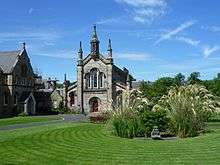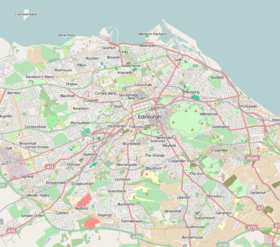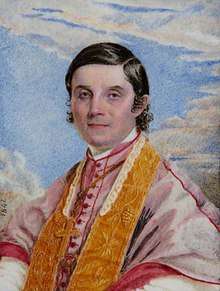Gillis Centre
Gillis Centre, formerly Gillis College and founded as St Margaret's Convent and School, is a complex of buildings situated close to the city centre of Edinburgh, Scotland. The history of the site can be traced back to the 15th century. The original building housed many literary figures of the eighteenth century, from 1834 it served as a convent and from 1986 to 1993 it was Gillis College, the seminary for the Roman Catholic Church in Scotland. It currently provides offices for the Curia of the Archdiocese of St Andrews and Edinburgh.[2]
| Gillis Centre | |
|---|---|
 Front of Gillis Centre showing St. Margaret's Chapel | |
 Gillis Centre Location of Gillis Centre within Edinburgh | |
| Location | Edinburgh |
| Country | UK |
| Denomination | Roman Catholic |
| Website | |
| History | |
| Former name(s) | St. Margaret's Convent, Gillis College |
| Status | Conference and Accommodation Centre |
| Founded | 1834 |
| Founder(s) | Bishop Gillis |
| Dedication | St Margaret of Scotland |
| Architecture | |
| Functional status | Active |
| Heritage designation | Category A listed building[1] |
| Designated | 14 December 1970[1] |
| Architect(s) | James Gillespie Graham and E. W. Pugin |
| Style | Gothic Revival |
| Completed | 1863 |
| Administration | |
| Parish | St. Peter's, Morningside |
| Deanery | St Giles' City of Edinburgh |
| Archdiocese | Archdiocese of St Andrews and Edinburgh |
| Province | St. Andrews and Edinburgh |
Early history
Whitehouse
The site of the present Gillis Centre was originally known as 'Whitehouse' and gave its name to the lane that runs alongside it, Whitehouse Loan. The house had many literary and academic occupants and must have had a connection with the University of Edinburgh, because it was there that some of the university's leading figures wrote various pieces of literature. Such as Principal Robertson who wrote his The History and Reign of Charles V in 1769.[3] In 1756 John Home wrote his tragedy Douglas there and in 1783 Dr. Hugh Blair wrote his famous Lectures.
St Margaret's Convent

In the 1830s, the Roman Catholic Church in Scotland was not yet re-established. James Gillis was a young priest, without influence, experience or worldly means but he wanted to establish a convent and so was sent by Bishop Paterson to the Continent to raise funds. On his journey via London, he was introduced to Miss Ann Agnes Trail[4], the daughter of a minister of the Established Church of Scotland. Subsequently on his return to England, Miss Trail wrote to him offering herself as a member of his projected Community. The other Scottish lady, Miss Margaret Clapperton, who was to be one of the founding members of the Community, came from Fochabers and had known James Gillis for much of her life. It was agreed that Miss Trail and Miss Clapperton should go together to Chavagnes, the Mother House of the Ursulines of Jesus[5] and they arrived there on 31 August 1833. Meanwhile, James Gillis managed in June 1834 to purchase a suitable house, known as Whitehouse, for his proposed Convent with 2 acres of ground for £3,000. The initial group of eleven Sisters comprising Miss Trail (now Sister Agnes Xavier), Miss Clapperton (now Sister Margaret Teresa), The Reverend Mother St Hilaire, Mother St Paula, Sister St Damian, Sister Alexis, Sister John Chrysostom, Sister Mary Emily, Sister Angelina and two lay Sisters, Sister Stephen and Sister Eustelle then travelled to Scotland but had to live elsewhere for four months while the Convent was being made ready. On 26 December 1834, the Community took possession of St Margaret's Convent, which was the first post-Reformation convent in Scotland. At St Margaret's, arrangements had been made for the reception of young lady boarders, whose education was to be the principal work of the Sisters. In 1835, the Feast of St Margaret was kept on 16 June and the new St Margaret's Chapel, which had been built alongside the Whitehouse Mansion House, was finished. In 1863, this chapel went on to house a relic of St. Margaret of Scotland. given by Bishop Gillis who had become Vicar Apostolic of the Eastern District (Scotland) in 1852. For over 150 years, until it was closed in 1986, it was well known in Edinburgh as St Margaret's Convent and School under the ministry of the Ursulines of Jesus.
Chapel
The chapel dedicated to St. Margaret of Scotland was designed by James Gillespie Graham (probably under significant influence from A.W.N. Pugin) and opened in 1835. From the same period, the gatehouse and convent building were also designed by James Gillespie Graham, and Edward Welby Pugin (son of A.W.N. Pugin) designed the school building which was completed in 1863.
Gillis College
In 1986, St Margaret's Convent School was closed much to the dismay of staff, pupils and parents. The Ursulines moved into St Margaret's Tower, 88 Strathern Road, which was adjoining the school site, where they remained until the property was sold in 2010. Although St Margaret's Convent was still owned in part by the Trustees of the Bishop Gillis Trust and in part by the Trustees of St Margaret's Convent, the seminary at St Andrew's College, Drygrange was moved in 1986 to St Margaret's becoming Gillis College, named after the founder of St Margaret's Convent, The Reverend Doctor James Gillis. On 29 January 1988, the two remaining Trustees of the Bishop Gillis Trust, The Most Reverend Keith Patrick O'Brien, Roman Catholic Archbishop of the Archdiocese of St Andrews and Edinburgh, and The Very Reverend Edward Provost Mohan, the Provost of the Chapter of the Archdiocese of St Andrews and Edinburgh transferred[6] without any payment the lands and buildings that were in 1988 on the lands bought by The Reverend James Gillis from Ann Oliphant In 1834 to the Trustees of the Archdiocese of St Andrews and Edinburgh, which included Archbishop O'Brien. Gillis College was the senior seminary of the archdiocese for the training of students for the priesthood and accepted seminarians from the dioceses of the Province of St Andrews and Edinburgh. In 1993, the theological college was closed[7] and the remaining students were sent to Bearsden, Glasgow, where the Scottish bishops had decided to have a National Seminary of Scotland, called Scotus College.
Gillis Centre

After the college closed the complex became the Gillis Centre, the Archdiocesan offices and agencies moved into the buildings and work began on developing a conference centre with residential accommodation. The Gillis Centre offered bed and breakfast accommodation until it was closed by the Trustees of the Archdiocese of St Andrews and Edinburgh on 30 November 2017[8].
The Gillis Centre provides a range of office accommodation for various diocesan commissions, bodies and organisations. In addition, it houses the theological library from the former Gillis College. The Diocesan Pastoral Office was closed[9] by Archbishop Leo Cushley on 30 November 2017, with most of its functions being transferred to five priests who were given appointments as Episcopal Vicars.
On 16 November 2008, the relic of St. Margaret of Scotland that was given to the chapel, when it was part of the Ursuline convent, by Bishop Gillis, was returned to St. Margaret's Memorial Church in Dunfermline, Fife.
Gallery
 View from Whitehouse Loan
View from Whitehouse Loan View from St Margaret's Road
View from St Margaret's Road
References
- Historic Environment Scotland. "113 Whitehouse Loan Gillis College RC Chapel (Category A) (LB30664)". Retrieved 25 March 2019.
- "Home - Archdiocese of Edinburgh". Archdiocese of Edinburgh. Retrieved 30 May 2019.
- The History and Reign of Charles V (London, 1769) 4 Vols.
- Trail, Ann Agnes History of St. Margaret's Convent, Edinburgh, the first religious house founded in Scotland since the so-called Reformation, (Edinburgh, 1886)
- "Ursulines of Jesus".
- Registers of Scotland, General Register of Sasines, Midlothian, Book 20041, Folio 236, Recorded 28 March 1988
- Gillis Centre and St Margaret's Chapel, Edinburgh by David P Woods, published August 2004
- "Scottish Catholic Observer".
- "Message on the Reform of the Curia" (PDF).